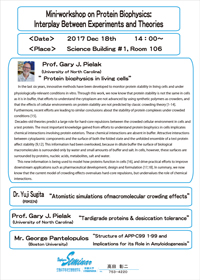This notice is to inform you of an upcoming workshop. All students and researchers of The Graduate School and Faculty of Science are welcomed to attend. No registration is required.
| Date/Time | Mon 18 Dec 2017, 14:00 |
|---|---|
| Venue | Graduate School of Science Bldg. No. 1 (Kyoto U, North Campus) 1st Floor, Room #106 |
| Lecture Titles |
|
| Registration | Not required |
| Language | English |
| Host | Dept Biophysics, Div Biology, Grad School Science, Kyoto University |
| Contact | Shoji Takada 075-753-4220 |
Professor Gary J. Pielak
University of North Carolina
Title: Protein biophysics in living cells
Abstract
In the last six years, innovative methods have been developed to monitor protein stability in living cells and under physiologically-relevant conditions in vitro. Through this work, we now know that protein stability is not the same in cells as it is in buffer, that efforts to understand the cytoplasm are not advanced by using synthetic polymers as crowders, and that the effects of cellular environments on protein stability are not predicted by classic crowding theory. Furthermore, recent efforts are leading to similar conclusions about the stability of protein complexes under crowded conditions.
Decades-old theories predict a large role for hard-core repulsions between the crowded cellular environment in cells and a test protein. The most important knowledge gained from efforts to understand protein biophysics in cells implicates chemical interactions involving protein exteriors. These chemical interactions are absent in buffer. Attractive interactions between cytoplasmic components and the surface of both the folded state and the unfolded ensemble of a test protein affect stability. This information had been overlooked, because in dilute buffer the surface of biological macromolecules is surrounded only by water and small amounts of buffer and salt. In cells, however, these surfaces are surrounded by proteins, nucleic acids, metabolites, salt and water.
This new information is being used to model how proteins function in cells, and drive practical efforts to improve downstream applications such as pharmaceutical development, design and formulation. In summary, we now know that the current model of crowding effects overvalues hard-core repulsions, but undervalues the role of chemical interactions.




